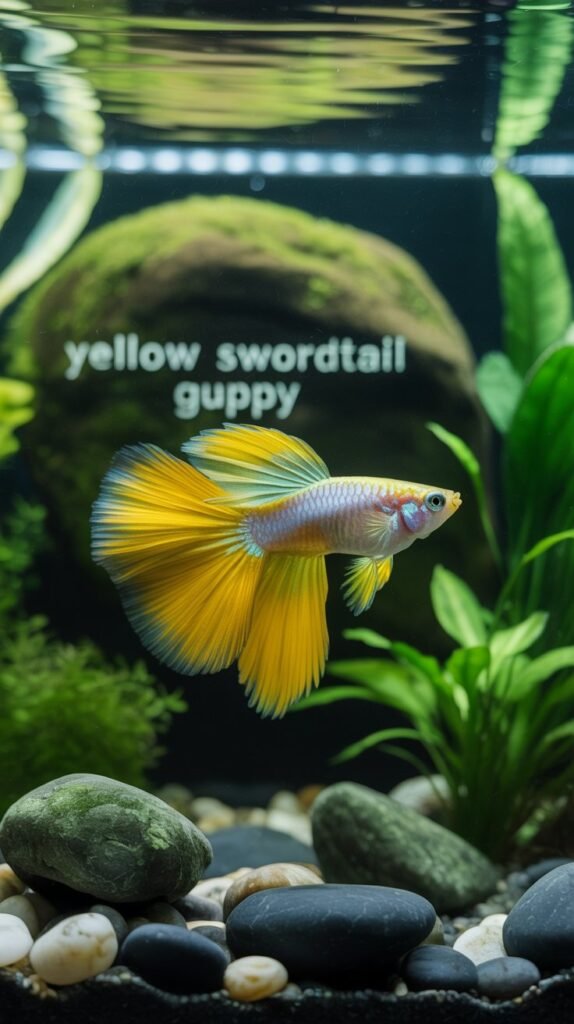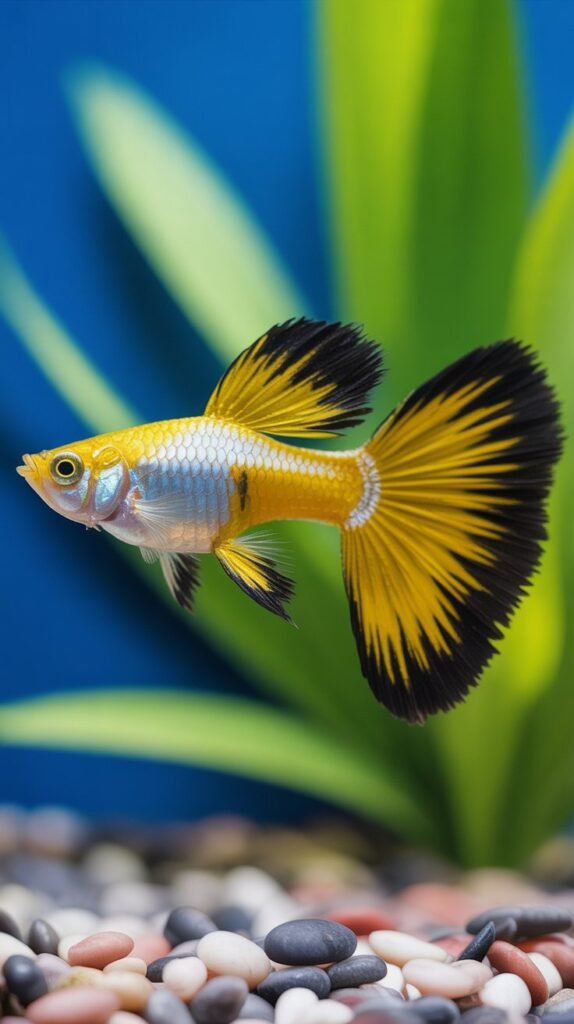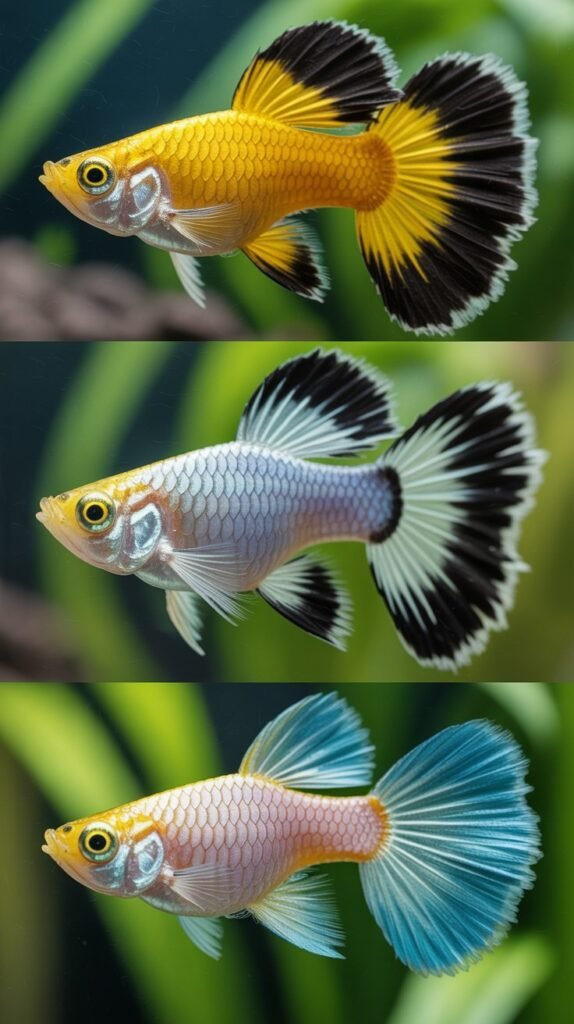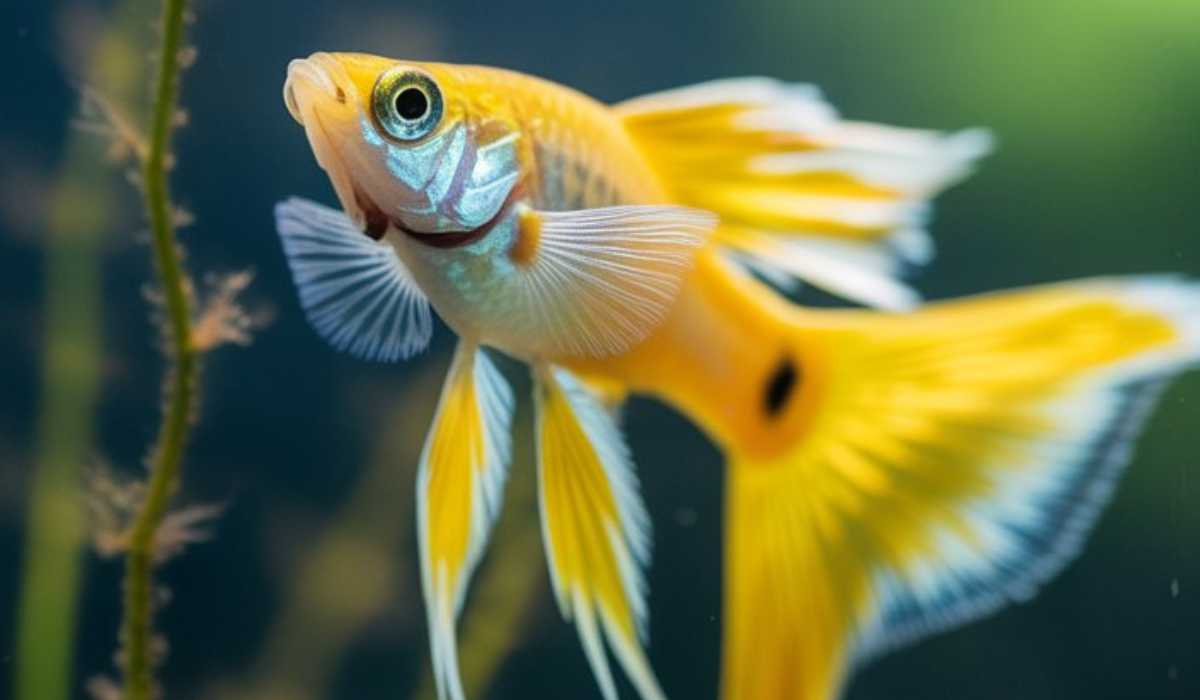The Yellow Swordtail Guppy is one of the most eye-catching and sought-after varieties in the guppy world. Known for its vibrant yellow coloration and the elongated tail fin that resembles a sword, this guppy is a true centerpiece for any aquarium. Guppies in general are famous for their adaptability, easy care, and beautiful patterns, but the Yellow Swordtail Guppy stands out because of its distinct tail shape and dazzling yellow hues. Whether you are a beginner aquarist or an experienced fishkeeper, this variety offers beauty, elegance, and activity that will enrich your aquarium experience
In this long-form guide, we will cover everything about the Yellow Swordtail Guppy, including its origins, physical traits, care requirements, diet, breeding practices, tank mates, and common health issues. By the end of this article, you will have a complete understanding of how to properly care for this remarkable fish and enjoy its charm in your home aquarium
Origins of the Yellow Swordtail Guppy
The Yellow Swordtail Guppy is a selectively bred strain of the Poecilia reticulata, commonly known as the guppy. While wild guppies are native to parts of South America, including Venezuela, Brazil, and Guyana, the Yellow Swordtail strain does not occur naturally in the wild. Instead, it is the result of careful selective breeding aimed at enhancing two main features: the bright yellow coloration and the sword-like extension of the caudal fin

Swordtail varieties are particularly valued in the guppy breeding community. The sword-like tail, which resembles that of the swordtail fish (Xiphophorus hellerii), gives these guppies a more exotic and dramatic appearance. Over decades, breeders have refined this strain to ensure consistency in color, shape, and fin length, making them one of the most popular guppy varieties available in the aquarium trade today
Appearance and Physical Traits
The Yellow Swordtail Guppy is known for its distinctive look. While body size and shape are similar to other guppies, the defining traits make them unique:
- Coloration: As the name suggests, these guppies display a brilliant yellow shade across their body and fins. The intensity of the yellow can range from pale lemon to deep golden hues depending on genetics and diet
- Tail Shape: The most defining feature is the sword-like tail. Males have an elongated lower portion of the caudal fin that resembles a blade, adding elegance to their swimming movements
- Size: On average, males grow around 1.5 to 2 inches, while females can reach up to 2.5 inches in length
- Sexual Dimorphism: Males are more vibrant and have the swordtail extension, while females are usually larger but less brightly colored. This makes it easy to distinguish between the two
When kept in a well-maintained aquarium with a proper diet, their colors become more vibrant and striking, making them a stunning focal point in community tanks
Temperament and Behavior
Yellow Swordtail Guppies are known for their peaceful and active nature. They are not aggressive and can easily coexist with other small, non-aggressive fish species. Males are often seen chasing females during breeding displays, and their long swordtails make them look particularly elegant while swimming
Some behaviors to expect include:
- Schooling Nature: They feel safer in groups and should ideally be kept in small groups of 6 or more
- Breeding Activity: Males will frequently court females, so it’s important to maintain the right male-to-female ratio (ideally 1 male to 2–3 females)
- Compatibility: They are excellent community fish and do well with other guppies, mollies, platies, rasboras, neon tetras, and corydoras catfish
Tank Requirements for Yellow Swordtail Guppies
A well-planned tank is essential for keeping Yellow Swordtail Guppies healthy and thriving. While they are hardy fish, providing the right environment ensures their colors remain vibrant and their lifespan reaches its potential
Tank Size
A minimum of 10 gallons is recommended for a small group, though 20 gallons or larger is ideal if you plan to keep multiple guppies along with other community fish
Water Parameters
- Temperature: 72°F to 82°F (22°C to 28°C)
- pH: 6.8 to 7.8
- Hardness: 8 to 12 dGH
- Ammonia/Nitrite: 0 ppm
- Nitrate: Below 20 ppm
Guppies are relatively tolerant of water conditions, but stability is key. Frequent water changes and proper filtration are essential
Filtration and Aeration

Use a gentle filter that provides adequate water circulation without creating strong currents. Sponge filters or hang-on-back filters are perfect for guppy tanks. Aeration is also beneficial to maintain oxygen levels
Tank Setup
- Substrate: Sand or fine gravel
- Plants: Live plants like java moss, hornwort, or guppy grass provide hiding spots and enhance the natural look
- Decorations: Use rocks, caves, and driftwood for enrichment, but leave enough swimming space
- Lighting: Moderate lighting helps bring out their yellow colors and supports plant growth
Diet and Feeding
Feeding the right diet is crucial for maintaining the health and coloration of Yellow Swordtail Guppies. They are omnivores, which means they need a balanced diet of both plant-based and protein-rich foods
Recommended Foods
- High-quality flake or pellet food: Special guppy or tropical fish formulations work best
- Frozen and live foods: Brine shrimp, daphnia, mosquito larvae, and bloodworms provide essential protein
- Vegetable matter: Blanched spinach, zucchini, or spirulina-based foods help support digestion
- Supplementation: Color-enhancing foods with carotenoids help maintain vibrant yellow hues
Feeding Tips
- Feed 2–3 small meals per day rather than one large feeding
- Remove uneaten food after 2–3 minutes to prevent water pollution
- Vary their diet to ensure balanced nutrition and strong immunity
Breeding Yellow Swordtail Guppies
One of the most fascinating aspects of guppies is their ease of breeding. Yellow Swordtail Guppies are livebearers, meaning females give birth to free-swimming fry rather than laying eggs
Breeding Process
- Pairing: Keep a ratio of one male to two or three females to reduce stress
- Gestation: The gestation period lasts about 21–30 days
- Fry Birth: Females can give birth to 20–100 fry at a time, depending on size and health
- Protecting Fry: Adults may eat the fry, so use breeding boxes, dense plants, or separate tanks for fry protection
Raising Fry
Fry should be fed with crushed flakes, baby brine shrimp, or microworms. Frequent small feedings help them grow quickly. Within a few weeks, they will begin to show color and develop their swordtail fins
Tank Mates for Yellow Swordtail Guppies

When selecting tank mates, choose peaceful and similarly sized fish. Good companions include:
- Neon tetras
- Corydoras catfish
- Mollies
- Platies
- Rasboras
- Dwarf gouramis (peaceful varieties)
Avoid aggressive species such as large cichlids, barbs, or bettas, as they may nip at the guppies’ fins or cause stress
Common Health Issues
Even though Yellow Swordtail Guppies are hardy, they can still be prone to common aquarium diseases if not cared for properly
- Ich (White Spot Disease): Small white spots on the body caused by parasites
- Fin Rot: Frayed fins caused by bacterial infection
- Swim Bladder Disorder: Difficulty swimming properly, often caused by poor diet or constipation
- Internal Parasites: Can lead to weight loss and lethargy
Maintaining clean water, offering a balanced diet, and avoiding overcrowding significantly reduce the risk of illness
Lifespan of Yellow Swordtail Guppies
With proper care, Yellow Swordtail Guppies can live for 2 to 3 years. Some may even live longer under optimal conditions. Genetics, diet, and tank maintenance all play a role in determining their longevity
Why Choose Yellow Swordtail Guppies?
- They add vibrant yellow coloration to your tank
- Their sword-like tail makes them visually unique
- They are peaceful and community-friendly
- They are easy to care for, making them great for beginners
- They breed easily, offering opportunities for hobbyist breeders
FAQs About Yellow Swordtail Guppies
Q1: How many Yellow Swordtail Guppies should I keep together?
It’s best to keep them in groups of at least 6 to promote natural schooling behavior and reduce stress
Q2: Do Yellow Swordtail Guppies need a heater?
Yes, since they are tropical fish, maintaining a water temperature between 72°F and 82°F is necessary
Q3: Can they live with shrimp or snails?
Yes, they are peaceful and can coexist with small invertebrates like cherry shrimp and nerite snails
Q4: How do I make their yellow color more vibrant?
Feed them a varied diet that includes color-enhancing foods, keep their tank clean, and provide proper lighting
Q5: Are they suitable for beginners?
Absolutely, their hardy nature and low-maintenance care make them one of the best choices for beginners
Q6: How fast do the fry grow?
With proper feeding and care, fry start showing colors within 4–6 weeks and can reach maturity in about 3 months
Q7: Can Yellow Swordtail Guppies be kept in outdoor ponds?
Yes, in warm climates they can thrive in ponds, but temperatures should not drop below 65°F
✅ Conclusion: The Yellow Swordtail Guppy is a brilliant and lively addition to any freshwater aquarium. Its stunning yellow color and elegant swordtail fin make it a centerpiece for both beginner and advanced aquarists. With proper care, diet, and tank conditions, these guppies will thrive and provide endless enjoyment in your aquatic setup

